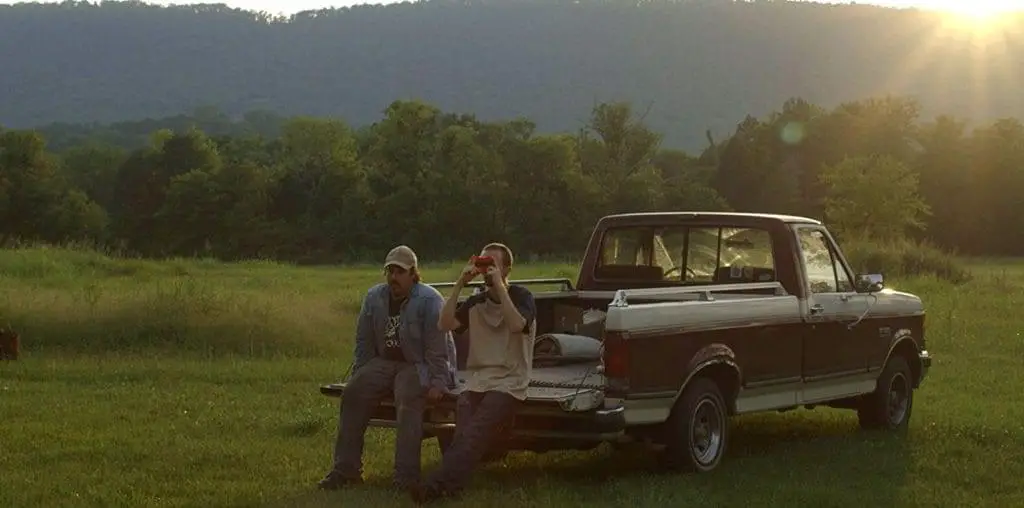
Meet Sudanese rap star and one-time child soldier Emmanuel Jal, who lived through a hellish war that left two million people dead and four million displaced. Even so, he’s retained his humanity. Rather than appear a hard, callous shell of a man, Jal radiates friendly charisma and boasts gentle, unassuming eyes. Even in a vicarious, onscreen relationship, viewers can’t help but feel that Jal is a concerned, warm-hearted presence. When this “Lost Boy” of Sudan smiles, pearly whites contrast coffee skin, and his charm is inescapable.
“War Child” is Jal’s miraculous life story. During the early eighties, this tall, lanky youngster spent his early childhood in Southern Sudan. At seven years old (Jal’s precise birth date remains in question), he was abruptly indoctrinated into the ranks of the Sudan People’s Liberation Army, alongside 10,000 other prepubescent soldiers. While many children are blessed with the tactile comforts of warm blankets, fluffy teddy bears, and downy pillows, orphaned Jal cradled and fired an oversized AK-47 assault rifle. His innocence-snuffing tour of duty wasn’t short-lived, either. Jal endured five years of brutal battlefield war in Ethiopia and Southern Sudan. “I didn’t have a life as a child,” described Jal. “In five years as a fighting boy, what was in my heart was to kill as many Muslims as possible.”
Flash forward to 2006. Now a twentysomething musical icon and spokesman for various anti-war organizations, Jal has survived and prospered. After securing a reputation as Africa’s fastest-rising musical hip-hop artist, he performs at club Ibiza in Washington, D.C. A shaman-like presence, his arms flail. “Stop treating Mama Africa like a vagina,” his voice rages. “She’s not your w***e, anymore! You take the riches, and you leave her people poor!” In “War Child,” this dredlocked, cheerful activist is also observed debating politicians, renting houses for orphaned children, and speaking to students about his unique life experiences.
How did Jaal transcend the horror of his battle-torn youth and transform himself into an approachable, optimistic voice of reason? How did he sidestep PTSD-prompted cynicism and despair, and avoid being another casualty of drug addiction, felony misdeeds, or suicide? By not forcing an answer to these questions, “War Child” prompts insight simply by taking us on an objective tour of Jal’s life. Allowing the story to tell itself (no emotional, one-sided Michael Moore flare-ups in this levelheaded film), “War Child” amazes us simply by acknowledging that Jal’s turbulent tale even exists.
“War Child” takes us back to 1983, educating us to Sudan’s civil conflict between the secular, southern based Sudan People’s Liberation Army, and the primarily Arab and Muslim north. We’re then jettisoned forward to 2007, where Jal raps from a classroom in Kenya’s Kakuma Refugee Camp. He speaks of the inevitable chaos that occurs when you “give someone with nothing to lose a weapon.” The film’s heroic subject reflects back on a thought that entered his mind during the worst of times: “I want a day that I can just live.”
Later in the film, Jal describes a childhood pilgrimage traveling from Sudan to Ethiopia, in which he and thousands of other children were promised “education” by the SPLA. (Ultimately, the “school” angle was merely a deceptive smokescreen, with these naïve youngsters lured to covert military camps and trained to fight.) At one harrowing point in the journey, Jal and hundreds of children boarded a ship, only to endure the capsizing of this overloaded watercraft. According to Jal, 360 children were initially taken on board. A mere 50 survived. As if this maritime tragedy wasn’t enough, Jal then staggered for hundreds of miles on foot, enduring animal attacks, starvation, and thirst. At one point, he debated whether or not to eat a dead comrade. Did I mention that Jal’s mother was killed, or that soldiers raped his sister?
Sound unbearably depressing? Hold on. “War Child” isn’t another “Conflict Documentary” that shoves our noses into the unsolvable tragedies of the world, before leaving us to stagger from the theater with contempt for mankind and suicide on our minds. After painting a necessarily harsh, clear-eyed picture of Jal’s upbringing, director C. Karim Chrobog presents redemption, rebirth, and relief. Emma McCune, a British aid worker, rescues Jal, smuggling the youth into Nairobi and treating him as an adopted son. Suddenly, a new lease on life has presented itself.
“War Child” provides plenty of Jal’s music, which he claims was the expressive anchor that kept him afloat during this brutal childhood sea of blood and bullets. Unlike many musicians who become entrenched in political movements as a side venture, Jal claims that his rap music career was selected entirely as a vehicle for his many activist platforms – which include ending war, poverty and child soldiers. A particularly emotional scene from “War Child” shows Jal collaborating with Sudanese Muslim musician Abdel Gadir Salim on the 2005 album “Ceasefire.” Preaching a message of co-existence and common ground, the record and its creators demonstrate how two men from radically contrasting ideologies (Jal is Christian) can unite to synthesize unified, meaningful art.
“Schindler’s List.” “The Killing Fields.” “El Norte.” “Saving Private Ryan.” Since its inception, cinema has allowed us vivid, vicarious entrance into life experiences that might otherwise sound absurd or impossible. “War Child” continues this tradition with the story of Emmanuel Jal, who survived unimaginable horrors before re-inventing himself to ensure that others might avoid them.

